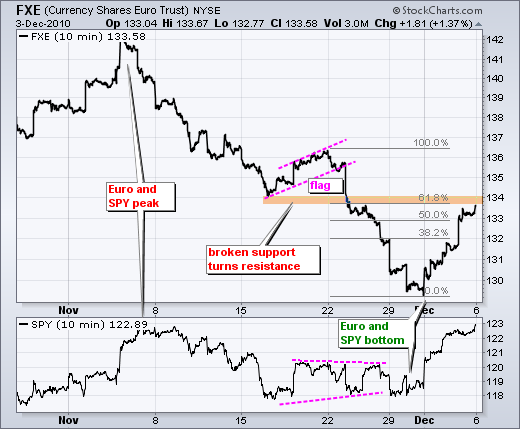The positive correlation between stocks and the Euro remains in place. The Euro got an oversold bounce last week and this helped propel stocks higher. Strong economic numbers on Wednesday also helped the bullish cause. Even though the Euro is getting a bounce, rising interest rates in the US and continued debt concerns in the Euro could limit this advance. On the price chart, we can also see the Euro Currency Trust (FXE) entering its first resistance zone. Broken support and the 62% retracement mark resistance in the 134 area. A downturn in the Euro could weigh on stocks, which are short-term overbought. The second chart shows the 10-year Treasury Yield ($TNX) breaking out last week. This means rates are moving higher and bonds lower. In case you are wondering, rising rates reflect strength in the economy and this is bullish for stocks. Yeah, I know, this argument presents a bit of a conundrum. Rising rates are bullish for the economy, stocks and the Dollar. Meanwhile, a downturn in the Euro would be bearish for stocks. What is most important here? The price charts for SPY and the major index ETFs take center stage for analysis. The Euro is on the second stage and interest rates occupy the third stage.


With leadership from the finance sector, the S&P 500 ETF (SPY) broke resistance with a gap and strong move last week. This breakout held and remains bullish until proven otherwise. Broken resistance turns into the first support level to watch. Key support is based on the November lows. A break below these lows would clearly reverse the uptrend on the daily chart. CCI broke into positive territory last week and moved above +100. This is a show of strength and momentum will be considered bullish as long as CCI stays in positive territory.

On the 60-minute chart, SPY is currently challenging the November highs around 123. IWM and MDY have already broken their November highs. QQQQ, DIA and SPY have yet to break these highs. Small-caps and mid-caps are leading this rally. It is also worth noting that short-term breadth indicators turned bullish with Wednesday's surge. See Thursday's post in Art's Charts for details. At this point, SPY is short-term overbought after a 4+ percent surge last week. This means we could see a pullback or consolidation. I am marking RSI support in the 40-50 zone. This is the area to expect momentum support in an uptrend.

I would like to welcome new readers to Art's Charts. Please see the About Link on the right navigation bar for details on these commentaries. Questions and comments are welcome. Note that I cannot personally respond to all questions. Many times issues are dealt with in a future commentary so other users can benefit. Before submitting a question or comment, please allow some time (a few weeks) to familiarize yourself with these commentaries.
Key Economic Reports:
Tue - Dec 07 - 09:00 – Bank of Canada Policy Statement
Wed - Dec 08 - 07:00 - MBA Mortgage Applications
Wed - Dec 08 - 10:30 - Crude Inventories
Wed - Dec 09 - 08:30 – Bank of England Policy Statement
Thu - Dec 09 - 08:30 - Initial Claims
Thu - Dec 09 - 08:30 - Continuing Claims
Thu - Dec 10 - 08:30 - Trade Balance
Fri - Dec 10 - 09:55 - Michigan Sentiment
Charts of Interest: Tuesday and Thursday in separate post.
-----------------------------------------------------------------------------
This commentary and charts-of-interest are designed to stimulate thinking. This analysis is not a recommendation to buy, sell, hold or sell short any security (stock ETF or otherwise). We all need to think for ourselves when it comes to trading our own accounts. First, it is the only way to really learn. Second, we are the only ones responsible for our decisions. Think of these charts as food for further analysis. Before making a trade, it is important to have a plan. Plan the trade and trade the plan. Among other things, this includes setting a trigger level, a target area and a stop-loss level. It is also important to plan for three possible price movements: advance, decline or sideways. Have a plan for all three scenarios BEFORE making the trade. Consider possible holding times. And finally, look at overall market conditions and sector/industry performance.
